In this article, I’ll share with you what is SWOT Analysis, how you can perform it, AND how you can track your success using this tool.
This guide also introduces a brand new tool called SWOT Strategy Canvas™ that supercharges your SWOT analysis for better performance and measurability.
Topics that I’ll cover are:
- What is SWOT Analysis in healthcare
- Benefits of SWOT Analysis in healthcare
- The 4 SWOT Analysis process
- How to conduct a SWOT analysis of your medical business
- What is the SWOT Strategy Canvas™ tool, and how to use it to track your medical business success?
- Examples of SWOT Analysis across the healthcare sector
- Practical SWOT action plan that you can quickly implement.
Without wasting too much time, let’s dig in.
What is SWOT analysis in healthcare?
While it might sound like you’re calling on a hostage-rescue law enforcement team, S.W.O.T is a strategic planning technique.
It is used to define your healthcare organization’s (or practice’s) Strengths, Weaknesses, Opportunities, and Threats in the competitive landscape.
SWOT Analysis arms you with a clear overview of critical metrics that are key for your performance and the overall success of your medical business.
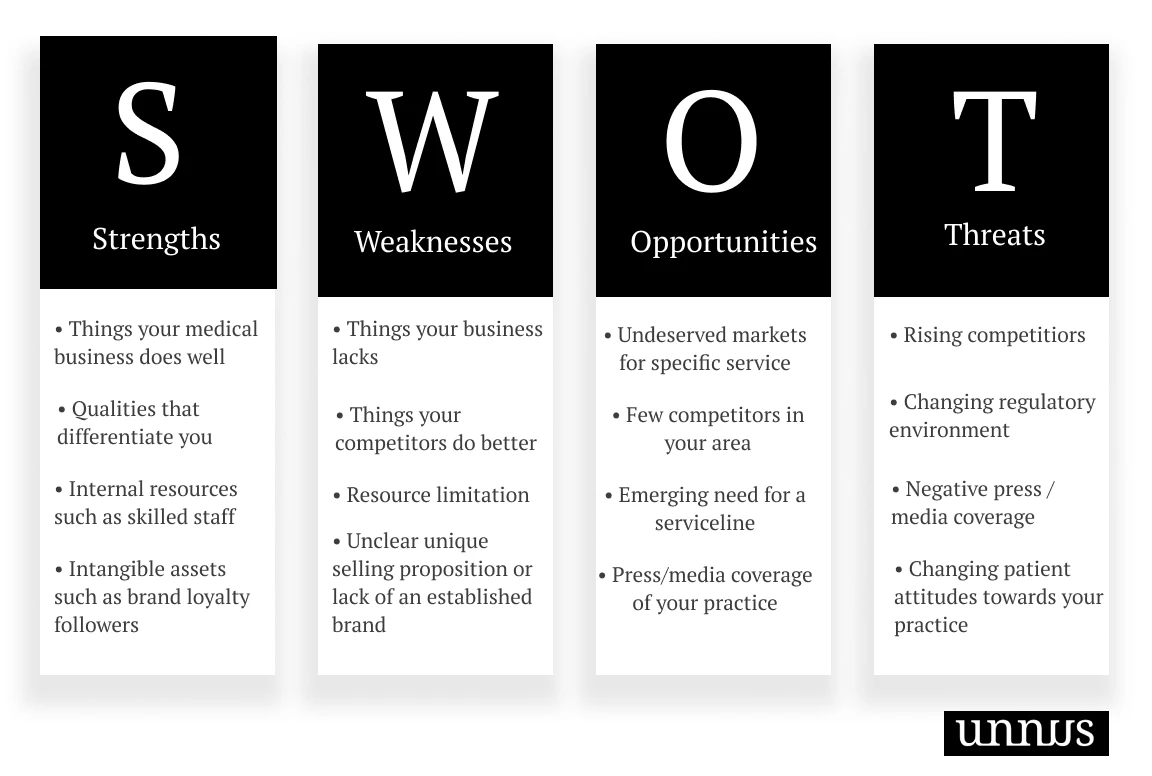
Benefits of SWOT Analysis in healthcare
There are countless benefits of conducting a SWOT analysis for your medical business. we’ll start by exploring a number of them.
1) SWOT Analysis arms you against future obstacles
Healthcare is a rapid and constantly changing industry. If you’re not ready for the forthcoming changes, you’ll have a hard time navigating the trenches.
Fortunately, SWOT is a proactive approach by design. When you sit down with your team and discuss future threats that could hinder your progress and profitability in the next year or two, you can prepare and develop strategies against any possible changes or uncertainty.
2) It uncovers the untapped opportunities for you to take advantage of.
No matter what kind of medical business you run, there’s always room for progress. But often, your business’s progress reaches a certain point and your growth will plateaus. This is a sign that you need to find new ideas to catapult your medical practice to the next level.
And here is where SWOT comes into play. It enables you to find new angles and possibilities that other competitors are not yet aware of. This supercharges your organization with competitive advantages when it comes to profitability and long-term success.
3) It gets your medical business out of the tunnel vision trap
We’re all biased towards our businesses. We think that our strengths far outweigh our weaknesses and in doing so, we disregard potential pitfalls that could break our whole organization. Being short-sighted when it comes to future decisions is the fast lane to a crumbling medical practice.
SWOT Analysis is one of the tools that we can use to combat our peripheral vision and be objective about our processes. The good news is, by performing SWOT, you drill down on your weaknesses and highlight all of your shortcomings so you can reverse them to strengths.
4) You can use SWOT Analysis to reverse engineer your competitors
Another great benefit of this technique is that you can use it to get a bird’s eye’s view of your competitive landscape. Just like you conduct a SWOT analysis of your organization, you can also perform it on your competition.
This will give you the unmatched advantage of being informed of competitors' strengths and weaknesses so you can act accordingly. If you’re in a competitive environment where the same care facilities are competing for the same patient at the same price, SWOT is irreplaceable.
The 4 SWOT Analysis Process
We know that SWOT stands for Strengths, Weaknesses, Opportunities, and Threats – but what does each of these elements mean? Let’s take a look at each element individually.
1) Strengths
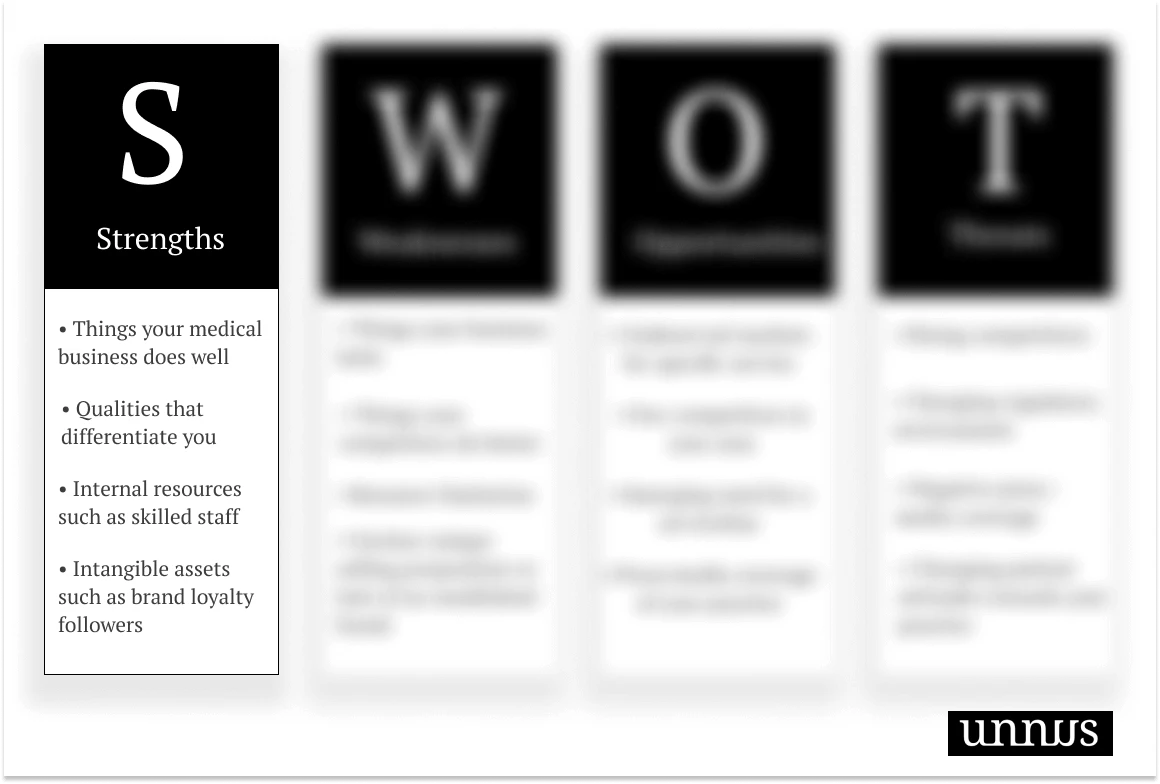
This element is focused on the strong attribute of your business. Be it a great service line portfolio, unique medical skills, or a convenient location. It is worth noting that your strengths can be intangibles like brand loyalty or an established brand name in the market.
2) Weaknesses

From our work with our clients, we noticed a common pattern when dealing with CEOs and medical business owners. Medical business owners are somewhat aware of the weak parts of their business lack, but the problem is that the assessment of how weak those parts are is most often inaccurate.
An example would be when we ask founders about their brand, they think that just because they have a logo or a design identity, they have a brand. But they lack critical parts of what makes up a profitable brand like unique positioning, brand culture, and communication frameworks. (if you’d like to learn more, check our healthcare branding guide ).
3) Opportunities
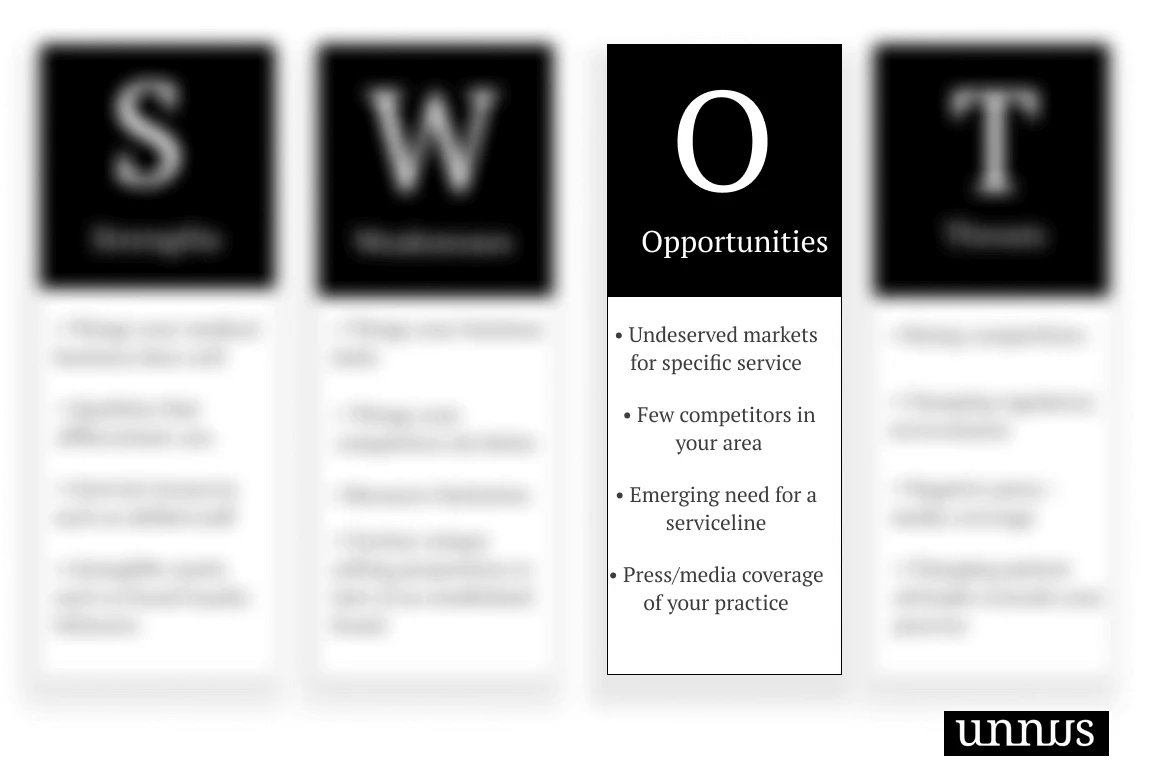
In this part of the process, we dig deep to find the unmet needs of your patients. Needs that if you manage to fulfill, you gain their trust and skyrocket your patient retention. Looking for market gaps in your respective field is a gold mine for business success.
You’d be surprised by how beneficial yet-easy-turn-a-blind-eye on opportunities you can take advantage of.
4) Threats
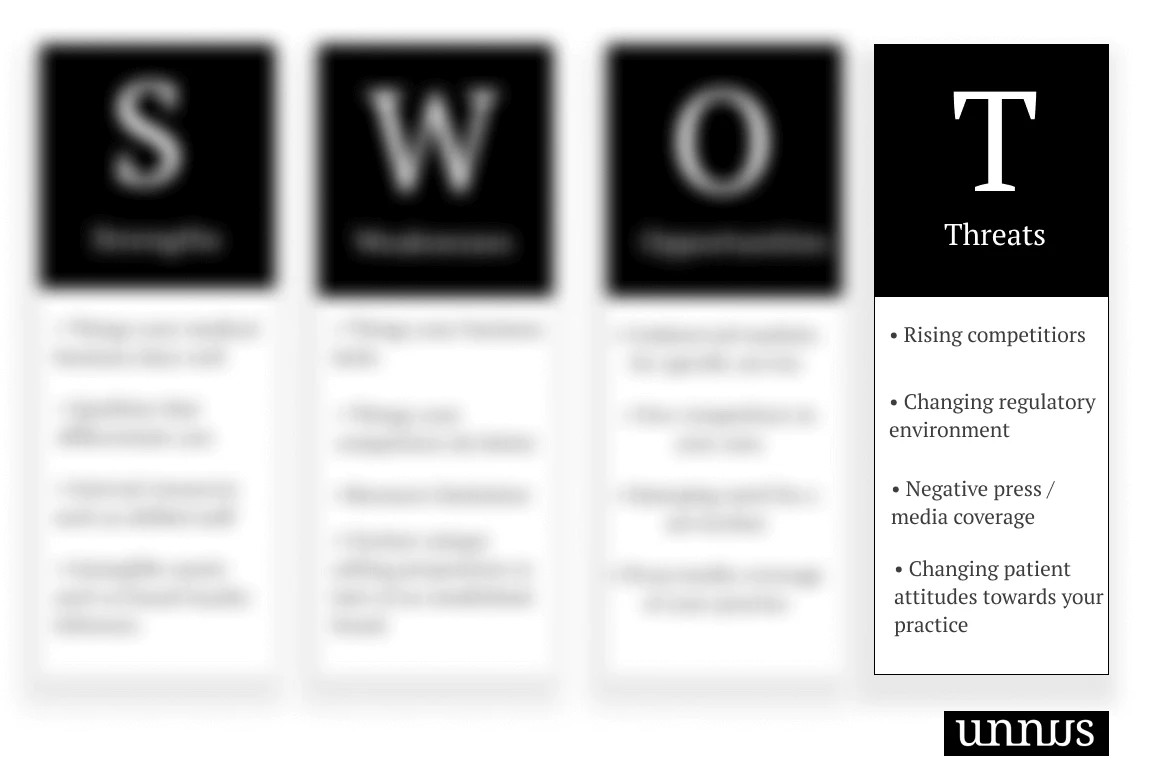
Threats are everything that poses a risk to either your brand itself or its likelihood of success or growth. This could include things like emerging competitors, changes in healthcare regulations, financial pressures, and all else that could jeopardize the future of your medical business.
Assessing threats is the proactive part of the process and it’s a great way to step out of the “reactive” mode business owners always get caught up in.
How to conduct SWOT analysis in healthcare
Now we’ve got all elements of SWOT analysis covered, it’s time to start conducting this technique on your business.
Draw Four Quadrants of SWOT Analysis
Each quadrant represents each element of the SWOT Analysis. This provides you with a visual grid as to where to write down your findings.
A simple example of a SWOT grid should be like this:
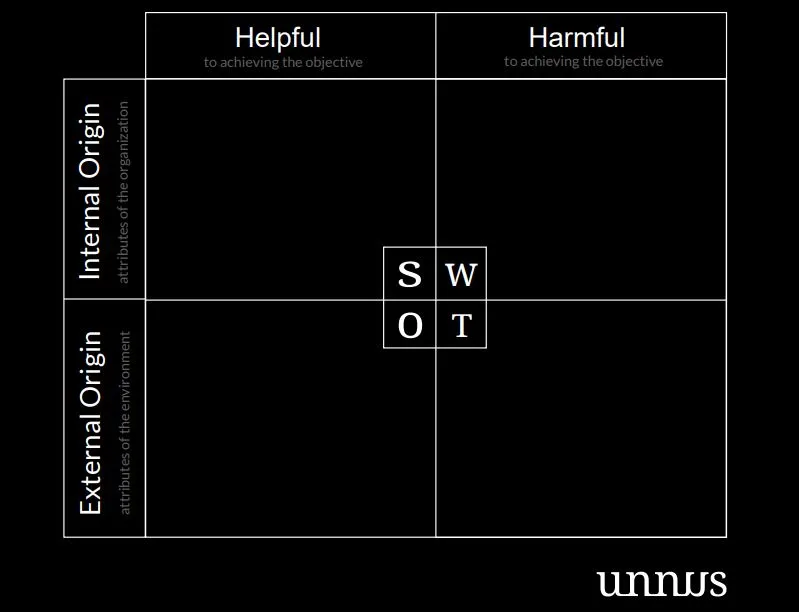
You can use our free healthcare SWOT Analysis Template
Gather the information
After that, you start by tackling each element of the analysis and asking questions that can provide you with great insights.
#~1) Let’s start with Strengths:
This should be the easiest part of the process since it’s your business’s strong suit. But if you’d like some supportive questions to get you running, here are some examples:
- What do your patients love about your brand or services?
- What does your practice or hospital do better than others in your industry?
- What are your most positive brand attributes?
- What’s your unique selling proposition?
- What resources do you have at your disposal that your competitors do not?
This should give you a rough outline of your fortes and competitive advantages.
#~2) Highlight your weaknesses:
Being objective about your weaknesses is critical. You should gather with your team to discuss some of the possible difficulties and flaws inside your organization.
You can use the same principle to determine your brand’s weaknesses:
- What do your patients dislike about your brand?
- What problems or complaints are often mentioned in your negative reviews?
- Why do your patients cancel or churn?
- What could your brand do better?
- What are your most negative brand attributes?
- What are the biggest obstacles/challenges in terms of revenue?
- What resources do your competitors have that you do not? (even if it is intangible like better brand awareness)
This could be a little hard to get through but it’s worth the collective effort. You and your team should be able to uncover hidden inefficiencies in your practice.
#~3) Snipe the opportunities and mitigate threats:
You may find that determining the strengths and weaknesses of your organization is easier or takes less time than figuring out the opportunities and threats. This is because strengths and weaknesses are internal factors.
External factors (Opportunities and Threats), on the other hand, tend to require more effort and rely upon more research, as these are often beyond your sphere of influence.
That’s not to say that opportunities and threats cannot be internal, however; you may discover opportunities and threats based on the strengths and weaknesses of your company.
Some possible questions you could ask to identify potential opportunities might include:
- How can we improve our patient experience/support processes?
- What kind of messaging resonates with our patients?
- How can we further engage our most vocal brand advocates?
- Are we allocating departmental resources effectively?
- Is there a budget, tools, or other resources that we’re not leveraging to full capacity?
- Which branding channels exceeded our expectations – and why?
Introducing the SWOT Strategy Canvas™, a visual representation to measure your success
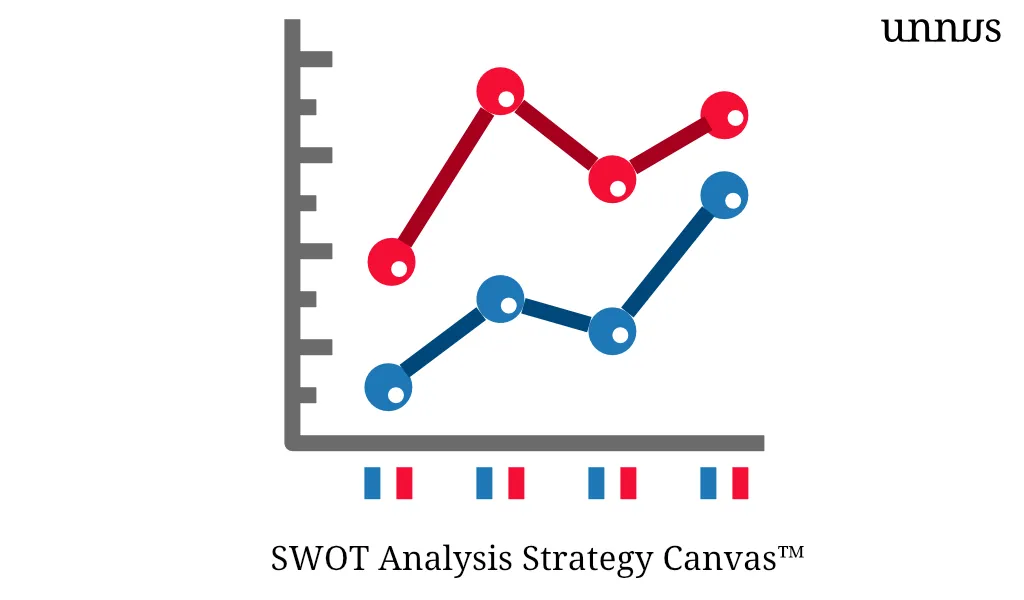
SWOT Analysis is insufficient alone to measure the success of your efforts or represent them visually.
That’s why our team at unnus developed the SWOT Strategy Canvas™ (SSC), a visual representation graph of the impact SWOT has on your healthcare brand. The SSC could be conducted every 6 months to track the efficiency and the effort of SWOT.
SSC graph tracks the Impact Rate of each element of the SWOT (strengths, weaknesses, opportunities, and threats). The goal is to witness a low Impact Rate of weakness and threats and a high Impact Rate of Strengths and Opportunities.
How to develop a SWOT Strategy Canvas™
#~First, When drawing the SSC graph, you need to split the SWOT elements into two separate lines.
The first line being Weaknesses-Strengths and will take the color blue, the second line on the graph is Opportunities-Threats and will take the color red.
You do that so you can better visualize their impact, more on this in a minute.
After that, you start drawing the x-axis and putting all of the data gathered from S.W.O.T in the following order:
1) Opportunities ➜ 2) Weaknesses ➜ 3) Strengths ➜ 4) Threats.
The x-axis will look like this:

#~Second, on the y-axis, is the Impact Rate. it ranges from zero to one, 0.5 being medium impact, 1 being high impact and 0 is none.
Here’s a good objective you should focus on:
- For the Weaknesses and Threats, you should aim for 0.2 rates or below.
- For the Opportunities, you should aim for 0.5 or above.
- For the Strengths, you should aim for 0.8 or above.
After you finish drawing your graph, your SSC graph should look like this:
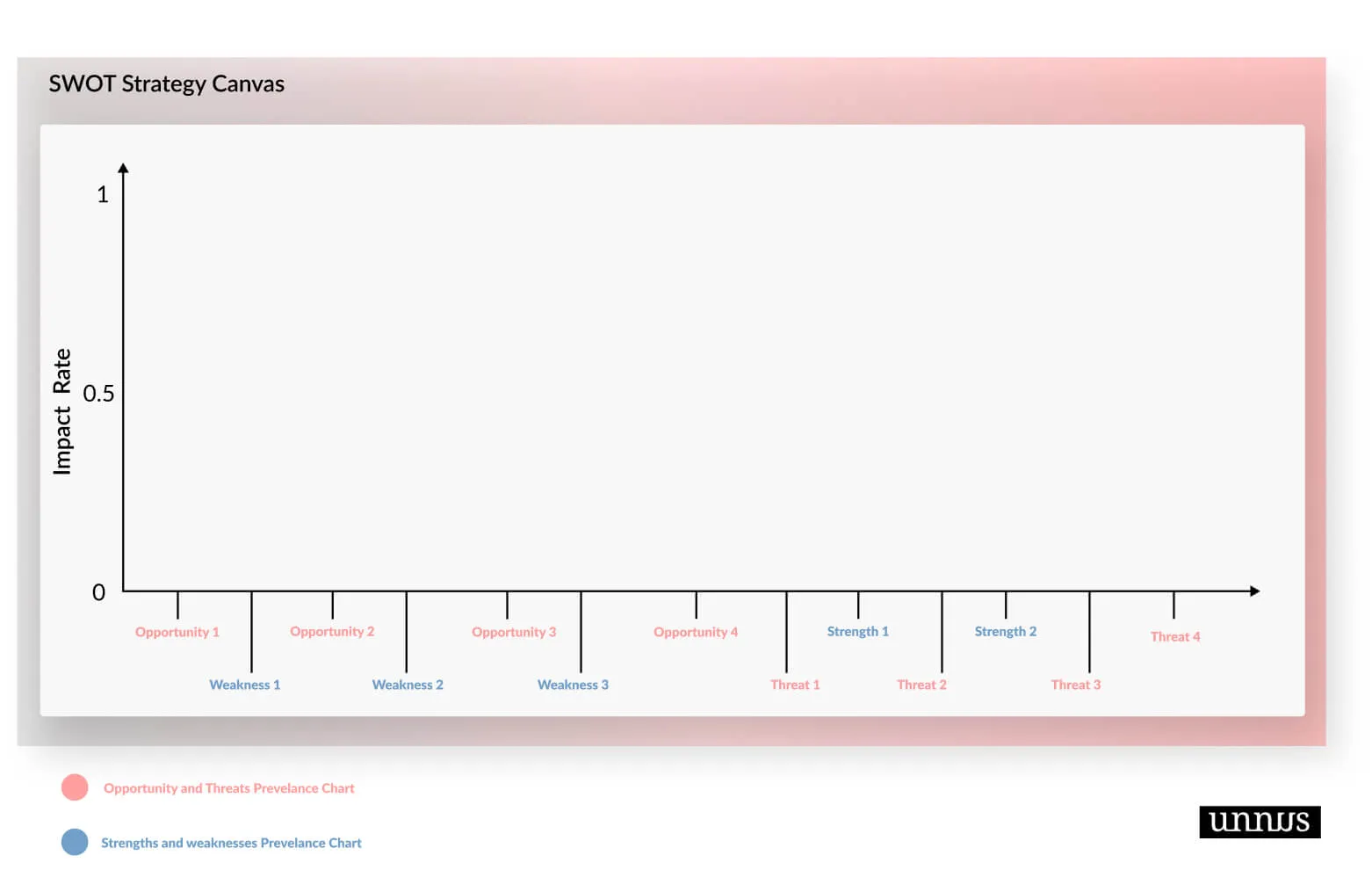
#~Third, let’s assume that you just finished conducting SWOT Analysis and you want to plot the current state of your company on SSC.
Before you use the SSC, you need to understand why we split elements into two lines (Weaknesses-Strengths and Opportunities-Threats) and why we gave each line a different color.
The reason for that order is simple: we want to see a divergence between the two lines (Weaknesses-Strengths line and Opportunities-Threats line). When the two lines diverge, it means that you managed to lower the impact of your business’s weaknesses and further improved your strengths.
It also means that the impact of the threats dwindled and got mitigated while opportunities have risen way up. (I’ll give example in a second)
This divergence is what you need to achieve. At first, the lines won’t diverge because you just got started. But after a year or two, you should start seeing a divergence between the two lines, signifying the success of your SWOT efforts.
#~Fourth, after filling the SSC graph with the data, you start by plotting and projecting the current impact of each S.W.O.T element of your business.
For each element ask yourself:
- If it’s a weakness: How much impact this weakness is having on hindering our medical business growth?
- If it’s an opportunity: What impact could this opportunity have on our business if we manage to take advantage of it?
- If it’s a Strength: How can we further improve on this competitive edge and what impact would we gain after this improvement?
- If it’s a threat: what’s the potential impact this threat would have on our business should we ignore it?
You don’t need an exact number, just rough estimates to help you gauge the current situation of your medical business.
Here’s an example of the SCC graph just after conducting a SWOT Analysis.
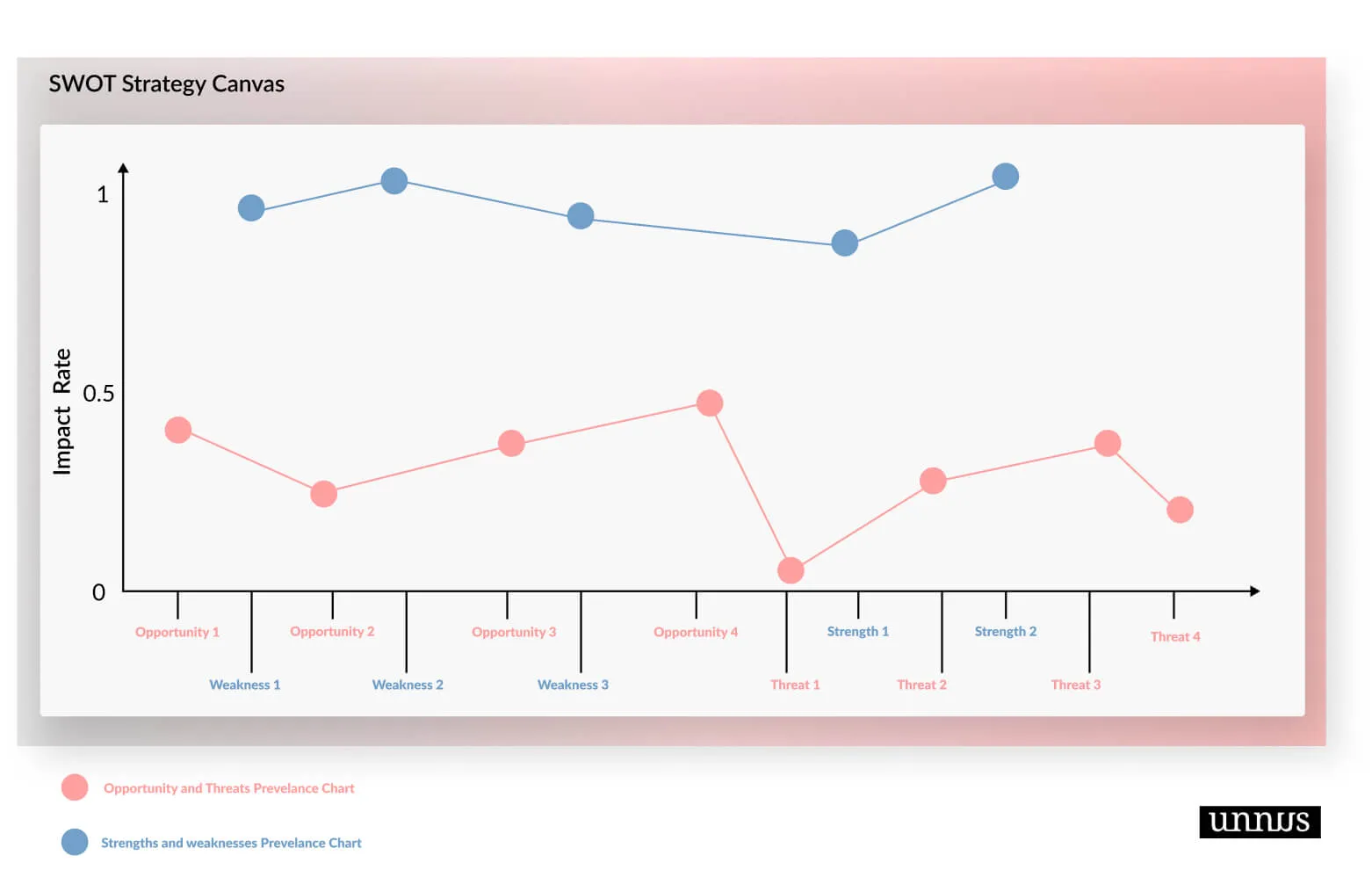
As you can see, Weaknesses and Strengths have a high impact by default since they are the current state of your business.
Opportunities-Threats are there but the impact of the threats should be lowered and the opportunities impact (or the potential impact in the case) should be higher.
And here’s an example of the SCC graph after acting out on the SWOT analysis (1 year after):
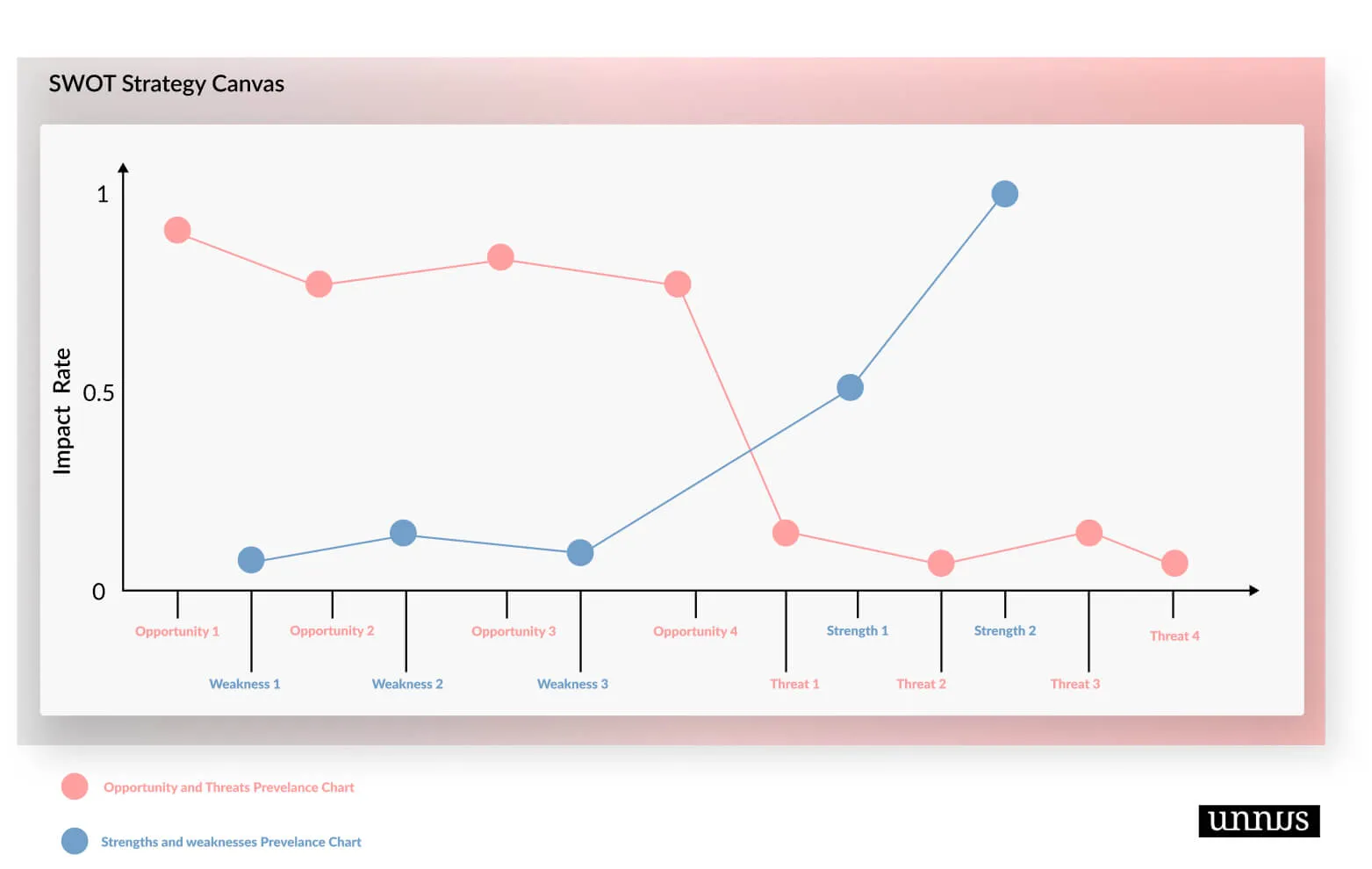
You can see that the lines are diverged signifying lower weaknesses and higher strengths, at the same time, reduced threats, and higher opportunities.
This is the power of the SSC, it gives a clear overview of the current SWOT effort and helps you see whether or not you’re on the right track.
Examples of SWOT analysis in healthcare
Now I’m going to share with you some of the best SWOT analyses across the healthcare industry so you can take some inspiration.
For the privacy’s sake of our clients, we won’t be sharing the names of their brands.
Hospital SWOT Analysis example
An example of a SWOT analysis for a hospital will look like this:
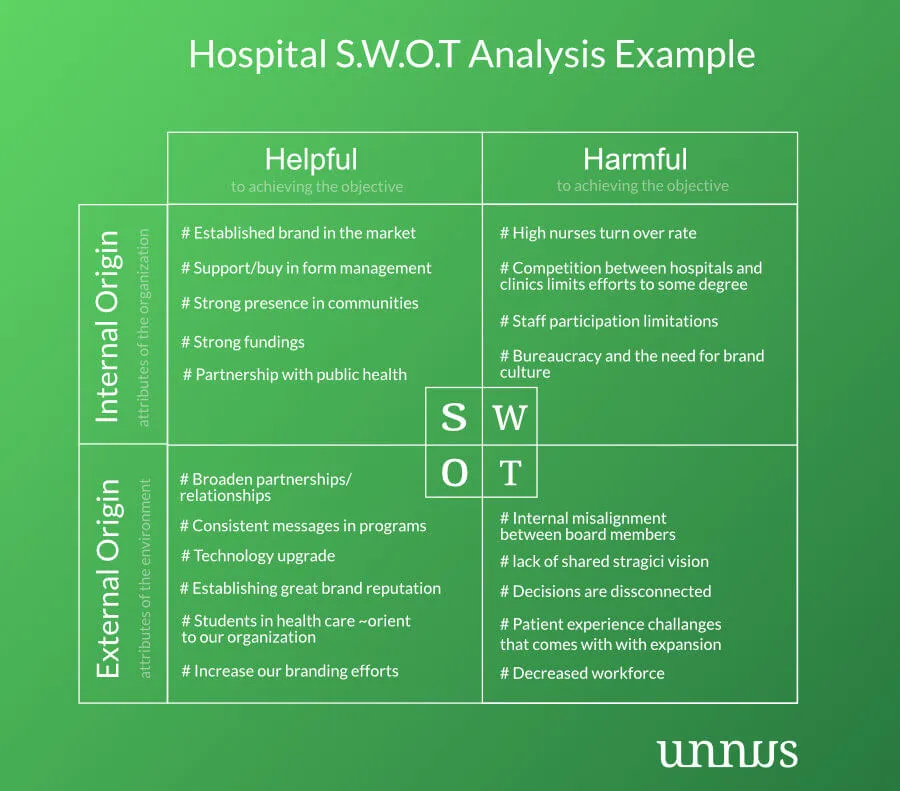
Another example from one of our client:

SWOT analysis for nurses example
The following S.W.O.T Analysis was conducted for a nurse-led clinic, an outpatient clinic that is managed by registered nurses.

Your Practical SWOT Action Plan (+example)

Having grasped the importance of SWOT analysis and observed its real-world application, it’s now time to dive into action with your own Practical SWOT Plan.
The following is a simple action plan that you can get inspiration from when acting upon your swot strategy.
You can download our free SWOT Task Tracker and print it out.
1) Leveraging Strengths
Tasks:
- Empowering Staff: Perform targeted training for the staff, elevating their expertise and skills.
- Build trust: Showcasing positive patient testimonials and glowing reviews.
- Reinforce marketing: Let your unique services and specialties shine brightly in your strategic marketing efforts.
- Enhance Referral Program: Open the floodgates to new patients with a new well-designed referral program.
2) Addressing Weaknesses
Tasks:
- Bridge skill gaps: through tailor-made training programs for your staff.
- Streamline workflows: with smart process improvements, optimizing every step.
- Uncover valuable insights: Seek feedback from both patients and staff.
- Learn from the best: Collaborate with other healthcare organizations to thrive together.
3) Seizing Opportunities
Tasks:
- Stay ahead of the curve: by expanding your services to meet emerging healthcare trends.
- Embrace technology: By revolutionizing patient engagement and elevating telemedicine capabilities.
- Forge powerful alliances and affiliations to access new patient populations.
- Cast your net wide: with precisely targeted marketing strategies for specific patient demographics.
4) Mitigating Threats
Tasks:
- Safeguard precious patient data with fortified cybersecurity protocols.
- Diversify your revenue streams, shattering reliance on a single source.
- Navigate the currents of healthcare policies and regulations, staying informed and vigilant.
- Arm yourself against adversity with rock-solid disaster preparedness plans.
5) Patient-Centric Actions
Tasks:
- Forge empathetic connections by communicating openly and addressing patient concerns.
- Empower patients through thoughtful education programs, championing their health autonomy.
- Listen and respond to patient feedback, embracing their suggestions for growth.
- Cultivate a nurturing community through patient support groups, fostering camaraderie and strength.
6) Monitoring and Evaluation
Tasks:
- Set sail with measurable goals and key performance indicators (KPIs) guiding your every move.
- Implement SWOT Strategy Canvas™ tool
- Embark on periodic reviews, charting progress and charting a course toward improvement.
- Steer your ship with invaluable insights from staff, patients, and stakeholders.
- Navigate with precision, harnessing data analytics to navigate the impact of your actions.
7) Adaptability and Continuous Improvement
Tasks:
- Cultivate an oasis of innovation, encouraging staff to share their brightest ideas and best practices.
- Ignite creative brilliance through regular brainstorming sessions, exploring new horizons together.
- Fuel the spirit of progress by recognizing and rewarding employees for their valuable contributions.
- Embrace the winds of change, setting sail toward new possibilities by staying attuned to industry trends and advancements.
These practical steps will provide a clear roadmap for success in implementing your SWOT Strategy. This will lift some of the hazy clouds surrounding how to implement this technique and leaves you with a step by step action plan for you to tackle.
The ‘secret’ to a battle-proven healthcare SWOT analysis
Effective SWOT Analysis must be carried with great execution. The tool might be easy to understand conceptually, but the devil lies in the details.
Risk assessment and marketing research is not something you can do half-assedly. It takes an experienced team and professional facilitators to pull off a result-oriented healthcare SWOT analysis.
If you’d like to run your own SWOT, we’re happy to chat with you about it .


